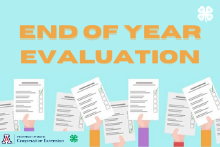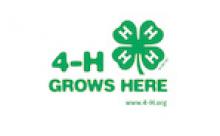Arizona 4-H Program Evaluation & Research
4-H is dedicated to understanding how its programs help youth become responsible citizens leading healthy and productive lives.
Grounded in a research-backed approach to positive youth development, Arizona 4‑H aims to evaluate the impact of 4‑H programs and better understand how young people experience the world. The Arizona 4-H program faculty, staff, volunteers, and youth contribute to 4-H program design, implementation, and improvement to ensure high-quality positive youth development. University of Arizona 4-H professionals will ask for evaluations at the end of specific programs and annually 4-H caring adults (volunteers) and 4-H members will be asked to complete a end of 4-H program year evaluation. These data are used to inform program quality improvement, communicate how the 4-H program improves young people's lives, and to justify program investments.
Evaluation is an important part of non-formal educational program planning. Evaluation generates information useful to explain what educational outcomes occurred because of the event and informs future revisions to the program. For an organization, it is important to be able to explain the value of their efforts and to be able to communicate, with supporting data, the story of the impact the organization is making.
End of Year 4-H Program Evaluation

Starting in 2020 Arizona 4-H professionals will ask 4-H volunteers and members to complete an annual 4-H program evaluation. This evaluation asked questions about knowledge change within a project, and also asks about the environment where the 4-H program took place, aspects like positive relationships, being welcomed or easy access to opportunities. This data will be invaluable to ensuring Arizona 4-H remains a high-quality positive youth development organization. We need your help to respond! Our goal is 50% response rate for volunteers and 30% for 4-H youth members. To thank you for your participation we sent up to 250 volunteers and youth gift cards!
The 2021-2022 4-H Program Year Evaluation timeline
- Your count-based 4-H professional will be reaching out to you to complete the end-of-year evaluation at events and via e-mail based on your county's schedule.
National 4-H Research

National 4-H Council has commissioned multiple research studies, including a longitudinal study to assess the effectiveness of its youth development programs and surveys on issues teens faces, such as digital access and mental health. Explore the National 4-H Council research page to learn more about these topics and more, and download full research reports.
Arizona 4-H Research

University of Arizona Cooperative Extension (UACE) 4-H professionals report the results from program evaluations, assess program effectiveness and establish new program ideas through peer-reviewed publications. The following publications are peer-reviewed results of Arizona programs conducted by UACE 4-H professionals.
Ashley Patricia Parra, Nicholas A. Morris, Jeremy Elliott-Engel
4-H is the largest positive youth development organization in the United States and is implemented by the land grant university system. To achieve program expansion, the century-old organization will need to recruit and retain millions more youth that reflect their increasingly diversified communities. Higher education has also worked to recruit and retain youth previously not engaged in college. This paper explores the hypothesis that there are lessons to be learned by the 4-H program from the literature on first-generation college students. Literature on risk factors and retention are presented for both first-generation college students and 4-H youth members. The two literatures are compared for similarities. Parallels existing between the experience of a first-generation college student entering an undergraduate program and the experience of a first-generation 4-H youth member entering the 4-H program were explored. Considerable overlap is found between recruitment and retention challenges in both audiences prior to enrollment/participation and during matriculation/participation providing considerable opportunities for 4-H and positive youth development organizations to identify adaptations to support first-generation youth members.
A Youth Perspective: The 4-H Teen's Leadership Identity Development Journey
Sarah A. Bush, Jeremy Elliott-Engel, Shannon Wiley, Tonya Price
A current focus of youth-serving organizations is youth leadership development with an objective of helping youth become productive contributors to society. 4-H is a leading organization in the effort to expose youth to leadership opportunities. This study examined the leadership identity development of 4-H youth serving in statewide leadership positions. The Leadership Identity Development (LID) model and mentoring mosaic served as the conceptual framework in this study. The purpose of this qualitative study is to shed light on the question, how do 4-H teens describe their journey to leadership? Youth reflected on the experiences, examples, and influences that impacted their leadership journey. The most common response for experiences that led to a 4-H youth’s choice to pursue a leadership role was a previous leadership experience. Leadership traits, Extension agents, and historical figures were the most frequently identified examples of leadership, and family members and Extension agents were commonly identified as influences. Four themes emerged from the youth perspectives: (1) leaders are characterized by traits, (2) individual-focused leaders, (3) team-oriented individuals, and (4) community contributors. The results corroborated with Stages 2-4 in the LID model. This study is a starting point for exploring leadership identity development of youth.
Joshua Farella, Joshua Moore, Juan Arias, Jeremy Elliott-Engel
Indigenous youth are systemically underserved by 4-H and other positive youth development (PYD) organizations. Many underserved First Nation communities in the United States could greatly benefit from programs that foster youth thriving; however, these programs tend to be ineffective in creating culturally reflective spaces for Indigenous participants. In this article, we argue that the Peoplehood Model should serve as a unifying model for the inclusion of Indigenous identity in programming, and that cultural humility should be firmly integrated into program design and assessment. We also propose that, to support Indigenous youth thriving, PYD practitioners must intentionally create a “partial vacuum” that supports youth creating program context and thriving.
Joshua Farella, Michael Hauser, Amy Parrott, Joshua D. Moore, Meghan Penrod, Jeremy Elliott-Engel
A literature review was conducted using the key words relating to Native American Youth and 4-H to assess the current state of 4-H youth programming serving First Nation/ Indigenous populations to inform future Extension initiatives. A systematic and qualitative review determined what level of focus the conducted programming efforts placed on broadly accepted elements of cultural identity as noted in the Peoplehood Model. A very small number of articles (N=13) were found pertaining to 4-H and Indigenous Communities. Fewer demonstrated emphasis on the peoplehood elements of language, place, traditional ceremony or calendars, and history. This work investigates a continuing inequity in 4-H PYD–both in service and reporting–and suggests some next steps for creating a more inclusive 4-H program for Native American/First Nation/Indigenous youth.
The Evaluation Skill-a-Thon: Evaluation Model for Meaningful Youth Engagement
Elizabeth Sparks, Michelle Molina, Natalie Shepp, Fiona Davey
Active engagement of youth participants in the evaluation process is an increasingly sought out method, but the field can still benefit from new methods that ease youth participatory evaluation implementation. Meaningful youth engagement in the evaluation process is particularly advantageous under the 4-H thriving model because of its potential to contribute to positive youth development, foster relationship building, enhance evaluation capacity, and improve program quality through improved evaluations. This program sought to facilitate actively engaging youth in the evaluation process by breaking it up into clear and manageable steps including evaluation design, data collection, data interpretation and analysis, reporting results, and outlining programmatic change. To achieve this aim, program staff designed the Evaluation Skill-a-Thon, a set of self-paced, experiential evaluation activities at various stations through which youth participants rotate. Actively involving youth participants in the evaluation process using the Skill-a-Thon model resulted in youth being able to identify and design programmatic changes, increased participation and response rates in other evaluations, and several youth participants’ gaining an interest in evaluation and working to design evaluations in later years. The Evaluation Skill-a-Thon holds promise for actively engaging youth participants in the entire evaluation process, easy implementation, and increasing evaluation capacity.
Jeremy Elliott-Engel, Kelly Robinson, Donna Westfall-Rudd
STEM literacy is identified as a necessary skill for participation in the future workforce. 4-H has responded to this need to develop STEM-ready youth by expanding access to project areas like Robotics. It has been acknowledged that recruiting and training STEM competent staff and volunteers is a limitation in expanding these types of programs. At the same time, 4-H youth are enrolled in many traditional non-STEM projects that are imbued with STEM concepts. 4-H volunteers with increased awareness of their role in fostering STEM education and STEM literacy can be a valuable resource in preparing 4-H youth with STEM-ready professional skills. 4-H professionals can train front-line volunteers to use an intentional STEM infusion approach within the experiential learning process. It is posited that volunteers will be better able to facilitate STEM learning in real-world contexts for a wide-range of 4-H youth by using this approach. The use of the ISI approach provides an opportunity for 4-H to develop more STEM-ready youth than by only serving those youths who are attracted to STEM-focused projects alone.

